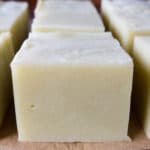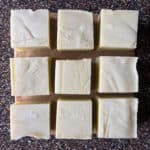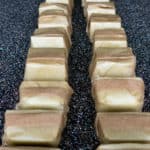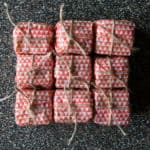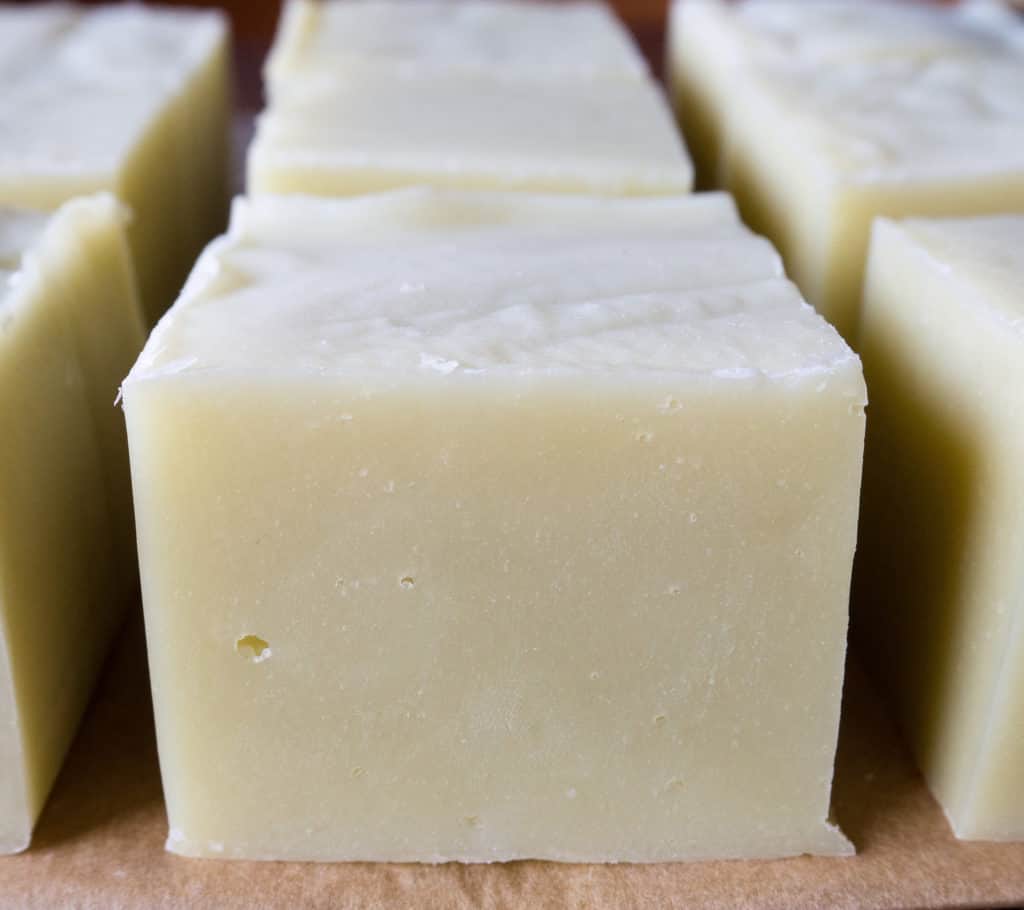
I love making Olive Oil Soap. It is so satisfying to make such a huge amount of soap, that is gluten free, that is vegan, that I can use without a skin rash or reaction. Not only do you know exactly what goes in to your soap it is also superb value for money.
This is my favourite soap it is an olive oil based soap (or castille soap). It is unscented and has a light green to cream colour depending on the type of olive oil you use. This recipe uses a cold process method.
Soap is an output from a chemical reaction (saponification) of sodium hydroxide (lye) and oils. It is a carefully calculated reaction and the recipe must be followed exactly. There are some very good books that provides great information on soap making and step by step instructions. I can recommend one (though not all the recipes are gluten free and vegan): The Soapmaker’s Companion by Susan Miller Cavitch*. It is available from Foyle’s via the affiliate link (*).
Allergy Information – Olive Oil Soap
Olive Oil Soap is gluten-free and vegan as well as… celery free, coconut free, garlic free, lupin free, mustard free, nightshade free, onion free, peanut free, sesame free, soya free, tree nut free.
Top Tips – Olive Oil Soap
This recipe will make around two kilograms of soap so you will need to plan your moulds. I use non-stick cake/ loaf tins and line them with greaseproof paper (I also add greaseproof paper strips under the lining to lift out the soap once it has set).
There is one thing you can tinker with safely and that is the scent – you add this at the end and adding essential oils does not affect the recipe. At Christmas I love frankincense, myrrh and cinnamon. I also love rosemary and Sicilian lemon. And lots of wonderful other scents. For this recipe you will need around 35 millilitres of essential oils.
WARNING!!!
Soap making is not for the faint hearted, those of a nervous disposition or risk takers. Sodium hydroxide (AKA lye) has a pH of 13 and is very, very corrosive – if you get it on your skin it will burn. However if you prepare well, put all safety aspects in place and take all necessary precautions and care during the soap making process you will fine and the output (lots of great soap) is worth it!
Steps you need to take include…
- Follow the recipe exactly. Any changes to the recipe, weights or proportions will result in a potentially dangerous result
- Ensure you use the correct amount of sodium hydroxide – accurately weigh your sodium hydroxide
- Wear long protective goggles, glasses and long sleeves
- Keep all children, pets, trip hazards away from your working area
- Work in a well ventilated area (I mix the sodium hydroxide and lye outside)
- Always add the sodium hydroxide to water NEVER the other way around
- Use heat proof glass containers: the sodium hydroxide solution will heat up very quickly to a very high temperature so be careful.
I cannot stress enough how important the above steps and common sense are. You must be confident you are taking all the necessary precautions to follow the recipe exactly and keep yourself intact. Making soap is at your own risk.
Instructions – Olive Oil Soap
Difficulty easy if you follow the instructions but used hazardous materials that must be handled appropriately
Makes approximately two kilograms of soap
Preparation time 90 minutes (including cooling time)
Cooking time 0 minutes
Equipment – Olive Oil Soap
Safety googles
Gloves
Moulds
Electronic weighing scales accurate to one gram (or less)
Heat proof glass container
Thermometer
Immersion blender
Ingredients – Olive Oil Soap
242 grams sodium hydroxide
554 grams distilled water
794 grams olive oil
794 grams coconut oil
57 grams castor oil
34 grams stearic acid
Method – Olive Oil Soap
1. Carefully prepare your mould(s) and line with greaseproof paper – make sure there are no creases or wrinkles
2. Set up your working area with all your equipment
3. Wearing your goggles, gloves and long sleeves weigh the sodium hydroxide and set aside
4. Place the heat proof glass container on your scales and zero the scale. Weigh out the distilled water. Slowly and gently add the sodium hydroxide to the water – stir will a metal spoon until the sodium hydroxide has dissolved. It will get very hot. Set aside to cool
5. Weigh out olive oil, coconut oil (NB may be solid at room temperature), castor oil and steric acid. Place the olive oil, coconut oil, castor oil and stearic acid in to a large pan and gently heat until the oils are melted and mixed – remove from heat
6. Once the sodium hydroxide solution has cooled to 27-39 C check the temperature of the oils. The oils should be within 10 C of the sodium hydroxide solution. If the oils are cooler heat gently until they are at the correct temperature
7. Add the sodium hydroxide solution to the oils and blend with the immersion blender. Keep blending until you see a ‘trace’ on the surface of the mixture. This could take between two and 10 minutes (depending upon temperature and pressure etc.). ‘Trace’ is where the soap leaves a pattern across the surface before sinking back in to the mass. If you are adding essential oils add them here and quickly blend to a uniform mix with the immersion blender
8. Quickly pour the soap in to the mould(s) – leave any crumbly or dry pieces in the pan
9. Place the mould(s) on a tray and cover with a frame (e.g. another tray or piece of board) and cover with a blanket or two. Leave undisturbed for 18-24 hours and then uncover
10. Once the soap is hard enough to remove from the mould(s) and slice (this could be one to seven days – I usually cut within one day) carefully remove the soap from the mould(s) (lifting with the strips of greaseproof paper) and gently peel back the greaseproof paper. Mark out the bar sizes on the surface of the soap and slice carefully
11. Place the bars in a single layer on a layer of greaseproof paper on a tray and place in a dry, well ventilated room (without dramatic changes in temperature). Allow the soap to cure for three to four weeks (turning once to ensure even curing). During this time the soap will become less alkaline, dryer and harder
12. Wrap the soaps with a breathable material.
